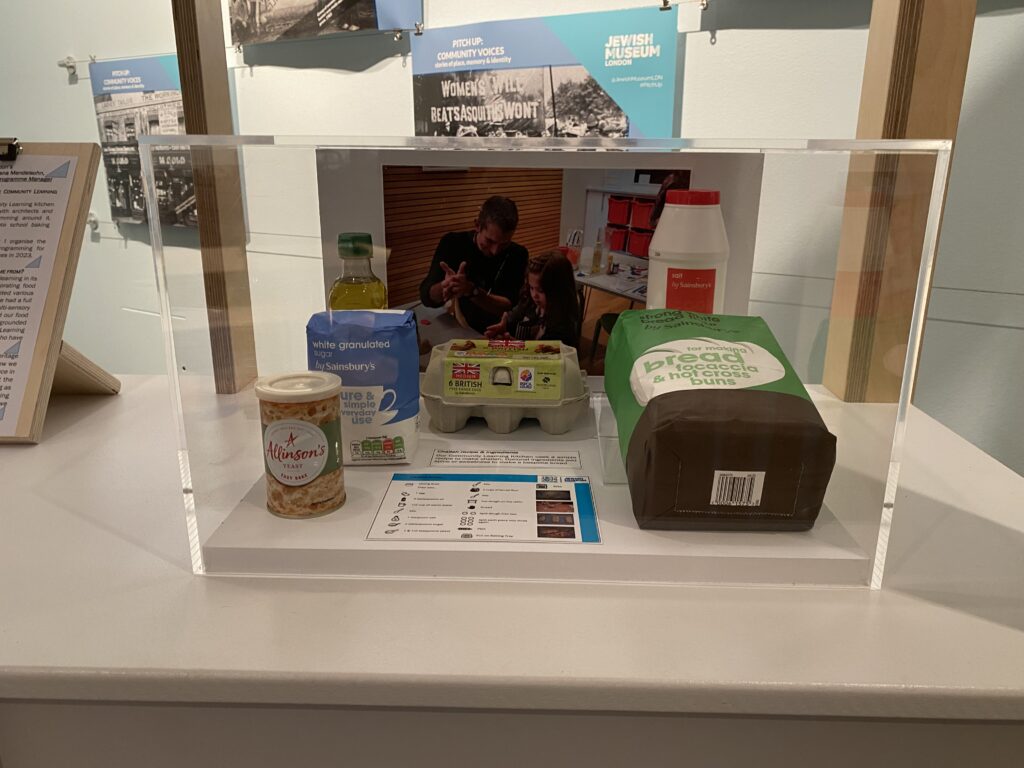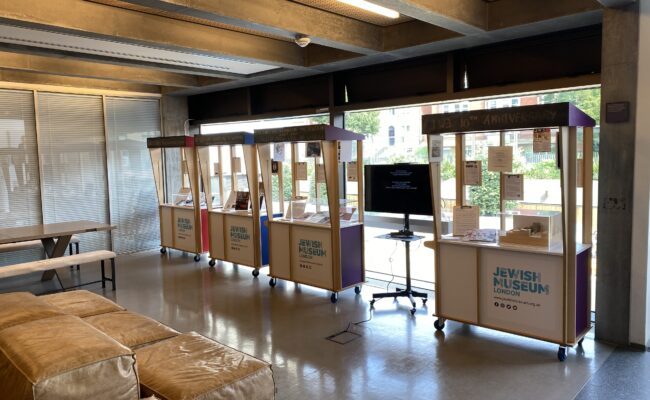A conversation between Jewish Museum London’s Adam Corsini, Senior Collections Manager, Eliana Mendelsohn, Learning Officer & Emma Crew, Engagement Programme Manager

Adam: How are you respectively involved in the Community Learning Kitchen?
Eliana: I was lucky to be involved in the Community Learning kitchen from the start, from its concept, to working with architects and designers, and then later on creating programming around it, particularly for school workshops. I now facilitate school baking workshops, making challah, and matzah.
Emma: As the Engagement Programme Manager I organise the informal learning activities in the kitchen, so programming for families, for general visitors, and also for new audiences in 2023.
Adam: where did the concept for the learning kitchen come from?
Eliana: The museum has always had an element of food learning in its formal and informal programming. We’ve been incorporating food tasting into our workshops for years, and we’ve also piloted various baking workshops (with just a single oven), even before we had a full working kitchen. Food Based Learning is one of those multi-sensory activities that appeals to all ages and abilities. We wanted our food learning to both connect to different Jewish festivals but be grounded in Jewish food heritage. The creation of our Community Learning Kitchen is thanks to the generous support of the band trust who have helped make our aspirations a reality.
Emma: As Jewish Museum London holds Britain’s Jewish heritage within its designated collection it’s important to think about how we can preserve Jewish food heritage too and make sure it has a place in the museum which we can pass on to people to make sure that the legacy is continued. It’s something that is still developing, still living as a living religion, as we like to always make sure that we’re getting across to people. So in terms of its importance it’s imperative that we have this kind of a space.
Museum: What’s been the response so far?
Emma: Oh, it’s been wonderful to see different families engaging with this space. I think one of my favourite things about the family programming is it really is families in the broadest sense. We have had families bringing young children to come and bake in the kitchen – I think the youngest being about six months old! – but we’ve also had families where the ‘children’ are adults, but they’re coming to bake with their parents or older relatives still. And I love the fact that the kitchen is really attracting visitors of all ages to come and bake together.
Eliana: For schools, the pupils are very excited that they’re allowed to cook and it’s always such a joy to watch them. They almost always get super messy but that’s part of the fun, watching their reaction when I say ‘go in with your hands – get the dough out on the table and start kneading’. They’re like, ‘Really?!’, and then get right in and involved. And there’s quite a bit of competition between the kids – whose challah is going to come out better? It’s brilliant. That tactile, multisensory learning is really special.
Emma: Sometimes families are apologising to me about the mess and offer to stay and help tidy up. But we reassure them that this is their space and they can be as free and creative as they want. It’s not necessary to be always neat and tidy. And you don’t need to worry about a mess, museums are meant to be fun!
Museum: What lessons have you learnt so far?
Emma: The main one is to try something different, because this was something I’ve never done before – leading baking workshops – and I didn’t really know what to expect. I was very keen to promote it not just for children under 12 and their families, but for people of all ages so they could come and bake in the space. It was quite a different way of programming and a different way of marketing for the museum.
Eliana: For schools, I think I’ve learnt that the more messy the session is the better it actually is. As someone who is generally quite tidy, at first I was thinking ‘Oh, my goodness, there’s flour everywhere, everything’s everywhere, It’s complete chaos’, but actually that is the best kind of session, because that means that the students have got loads from the session. And most importantly, they’ve had fun. And that’s the whole point really.
———————————————————————————————-
For more information visit: www.jewishmuseum.org.uk/events/
Selecting an object
Emma: We wanted to display how our challah baking is actually very diverse. What’s really lovely about the challah recipe that we use with general visitors is that isn’t just one challah recipe. And that’s because there isn’t just one type of challah that all Jewish people eat around the world. Challah is very different for different communities.
For Ashkenazi communities, it tends to be a very sweet bread. But for Sephardi and Mizrachi communities, particularly in places like North Africa, and places like Asia, challah can be quite savoury. So whilst everyone will be adding some strong bread flour, some oil, some sugars, and salts, and yeast, there’s also the options for people to add individual ingredients that try to replicate the taste of challah bread from different countries around the world. We’ve got different seeds and spices, honey is very popular as well. Chocolate is always popular!
Eliana: for schools we tend to stick to a classic recipe mainly due to time making sure their challah can go in the oven and come out looking like a challah bread. But what’s lovely is how everyone has the same ingredients but their designs, the way they plait the dough, mean that every piece of challah baked is unique. And again that’s really something quite special about the Learning Kitchen.
